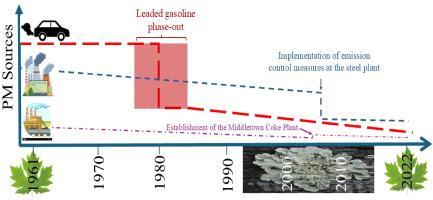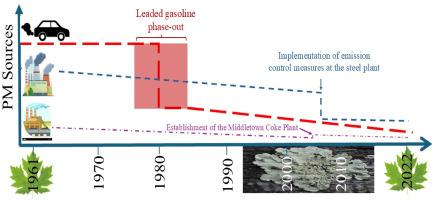工业城市颗粒物质丰度和来源的长期变化:来自显微镜和生物监测仪元素和铅同位素组成的见解
IF 7.3
2区 环境科学与生态学
Q1 ENVIRONMENTAL SCIENCES
引用次数: 0
摘要
本研究首次采用显微、元素和同位素方法对存档生物监测仪中颗粒物(PM)丰度、元素组成和来源的长期变化进行了定量重建。我们比较了1961年和2022年从俄亥俄州米德尔敦一家钢铁厂附近的公园收集的两组落叶。此外,从米德尔敦收集的一组地衣样本进行了与叶片样本相同的元素和同位素分析,以更好地了解该地区的时间集成PM来源。显微研究表明,1961年叶片单位表面积上PM的平均滞留量是2022年叶片的17倍。Pb同位素表明,历史平均PM质量分别为533±139、343±36、435±130和139±14 mg m-2,当代源PM质量分别为30±6、23±3、17±2和12±1 mg m-2。这表明,PM的主要人为来源将从1961年的汽油转向2022年的钢铁厂,这可能是由于含铅汽油的逐步淘汰。元素分析显示,与当代叶片相比,20世纪60年代该植物的PM排放量高出15倍,并且含有更广泛的元素浓度升高。此外,地衣样本(估计可追溯到20世纪80年代末至90年代末)显示出与钢铁厂排放相关的Al、Cr、Fe和V的浓度显著升高,其中来自钢铁厂的PM的人为相对贡献最高,表明在2006年实施污染控制措施之前,钢铁厂排放的影响很大。总的来说,这些发现强调,尽管在过去60年中观察到PM排放量显著下降,但钢铁厂对环境的影响仍在继续。本文章由计算机程序翻译,如有差异,请以英文原文为准。


Long-term changes in particulate matter abundance and sources in an industrial city: Insights from microscopy and elemental and Pb isotopic compositions of bio-monitors
This study presents the first quantitative reconstruction of long-term changes in particulate matter (PM) abundance, elemental compositions, and sources using a combination of microscopic, elemental, and isotopic methods in archived biomonitors. We compared two sets of deciduous leaves collected from a park near a steel plant in Middletown, Ohio, in 1961 and 2022. Additionally, a set of lichen samples collected from Middletown underwent the same elemental and isotopic analysis as the leaf samples to better understand time-integrated PM sources in the region. Microscopic investigations revealed that the average amount of PM retained on the unit surface area of the 1961 leaves was 17 times higher than that of the 2022 leaves. Pb isotopes indicated that historical average PM masses originating from glacial till, the steel plant, gasoline, and fly ash were 533 ± 139, 343 ± 36, 435 ± 130, and 139 ± 14 mg m−2 respectively, while the corresponding values for the contemporary sources were 30 ± 6, 23 ± 3, 17 ± 2, and 12 ± 1 mg m−2. This suggests a shift in the primary anthropogenic source of PM from gasoline in 1961 to the steel plant in 2022, likely due to the phase-out of leaded gasoline. Elemental analysis revealed that PM emissions from the plant in the 1960s were 15 times higher and contained elevated concentrations of a wider range of elements compared to contemporary leaves. Further, lichen samples (estimated to date back to the late1980s to late 1990s) exhibited significantly elevated concentrations of Al, Cr, Fe, and V associated with steel plant emissions, with the highest anthropogenic relative contribution of PM originating from the steel plant, indicating the high impact of steel plant emissions prior to implementation of pollution control measures in 2006. Overall, these findings underscore that despite the significant decline in PM emissions observed over the last 60 years, the environmental impact of the steel plant continues.
求助全文
通过发布文献求助,成功后即可免费获取论文全文。
去求助
来源期刊

Environmental Pollution
环境科学-环境科学
CiteScore
16.00
自引率
6.70%
发文量
2082
审稿时长
2.9 months
期刊介绍:
Environmental Pollution is an international peer-reviewed journal that publishes high-quality research papers and review articles covering all aspects of environmental pollution and its impacts on ecosystems and human health.
Subject areas include, but are not limited to:
• Sources and occurrences of pollutants that are clearly defined and measured in environmental compartments, food and food-related items, and human bodies;
• Interlinks between contaminant exposure and biological, ecological, and human health effects, including those of climate change;
• Contaminants of emerging concerns (including but not limited to antibiotic resistant microorganisms or genes, microplastics/nanoplastics, electronic wastes, light, and noise) and/or their biological, ecological, or human health effects;
• Laboratory and field studies on the remediation/mitigation of environmental pollution via new techniques and with clear links to biological, ecological, or human health effects;
• Modeling of pollution processes, patterns, or trends that is of clear environmental and/or human health interest;
• New techniques that measure and examine environmental occurrences, transport, behavior, and effects of pollutants within the environment or the laboratory, provided that they can be clearly used to address problems within regional or global environmental compartments.
 求助内容:
求助内容: 应助结果提醒方式:
应助结果提醒方式:


